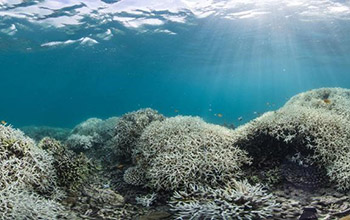
Research News
Device could be used to find threats to ecosystems
February 4, 2020
Imagine a device that could swiftly analyze microbes in oceans and other aquatic environments, revealing the health of these organisms — which are too tiny to be seen by the naked eye — and their response to threats in their ecosystems.
Now researchers have created such a tool, a portable device that could be used to assess microbes, screen for antibiotic-resistant bacteria and analyze algae that live in coral reefs. The work is published in the journal Scientific Reports.
The tool, developed initially to assess algae, can determine in the field or in laboratories how microbes and cells respond to environmental stresses, such as pollution and changes in temperature or water salinity.
“Our goal was to develop a novel way of assessing cell health that did not rely on using expensive and complex genomic tools,” said co-senior author Debashish Bhattacharya of Rutgers University. “Being able to assess and understand the status of cells, without having to send samples back to the lab, can allow the identification of threatened ecosystems based on a ‘stress index’ of their inhabitants.”
The NSF-funded research focused on a well-studied green microalga, Picochlorum. The tool can quickly reveal whether a cell is stressed, robust or unaffected by environmental conditions. Microbes pass one by one through a micro-channel, thinner than the diameter of a human hair. Impedance, or the amount an electrical field in the tool is perturbed when a cell passes through the channel, is measured. Impedance varies among cells in a population, reflecting their size and physiological state, which provide important readouts of health.
“This valuable instrument for assessing the health and characteristics of microbes in the environment at the level of the single cell offers an alternative approach that is more cost-efficient then other current single-cell techniques,” said Robert Fleischmann, a program director in NSF’s Division of Biological Infrastructure. “Scientists can adopt it without the need for more costly and complex equipment.”
—
NSF Public Affairs,
researchnews@nsf.gov








